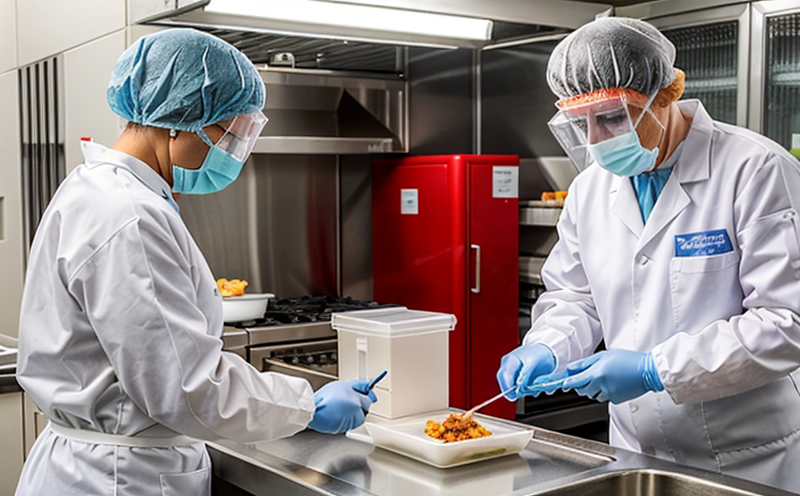Codex CAC/GL 91 Guidelines for Viral Pathogen Testing in Food Products
The Codex Alimentarius Commission's Codex Alimentarius is a global reference standard that sets harmonized food safety standards, guidelines and codes of practice. One such guideline is CAC/GL 91, which provides essential recommendations for the testing of viral pathogens in foods. This service ensures compliance with these guidelines to ensure safe and wholesome food products.
The Codex CAC/GL 91 establishes a framework that helps laboratories design, validate, and implement reliable methods for detecting viruses such as Rotavirus, Hepatitis A virus (HAV), Ebola virus, and others. Compliance with these guidelines is crucial not only to meet regulatory requirements but also to protect public health.
The service covers the entire lifecycle of viral pathogen testing, from sample collection through analysis and reporting. Our laboratory adheres strictly to the procedures outlined in CAC/GL 91 to ensure accurate results that are acceptable for regulatory purposes. We utilize advanced technologies and techniques, ensuring precision and reliability in our test outcomes.
Our approach includes:
- Detailed Sampling Procedures: Our experts follow strict protocols for sample collection to minimize the risk of contamination and ensure representative samples.
- Laboratory Validation: We validate all tests according to CAC/GL 91, ensuring that our methods are both sensitive and specific.
- Data Analysis: Advanced bioinformatics tools support accurate data interpretation and reporting.
- Certified Reporting: Our reports comply with the latest standards set by Codex Alimentarius to ensure transparency and trustworthiness.
The service is designed for a variety of stakeholders including quality managers, compliance officers, R&D engineers, and procurement teams. By adhering strictly to CAC/GL 91 guidelines, we provide robust support in ensuring food safety and regulatory compliance.
Understanding the broader context, viral pathogens can pose significant risks if not properly controlled at every stage of production and distribution. Compliance with these standards ensures that the testing process is consistent and reliable, thereby contributing significantly to public health protection. This service is part of our comprehensive suite aimed at safeguarding food safety within the Codex framework.
Why It Matters
The importance of complying with CAC/GL 91 cannot be overstated, especially in an era where foodborne illnesses can have severe public health implications. Compliance with this guideline ensures that food products are safe for consumption and meets international standards set by the Codex Alimentarius Commission.
Firstly, it helps maintain consumer trust by ensuring that all food products meet stringent safety criteria. Secondly, compliance aids in protecting against potential recalls or legal actions due to contamination incidents. Lastly, it contributes positively towards public health by reducing instances of foodborne illnesses associated with viral pathogens.
Our service not only ensures regulatory compliance but also enhances the reputation of our clients by demonstrating a commitment to quality and safety. By adhering strictly to CAC/GL 91 guidelines, we contribute significantly toward safeguarding global food supply chains against threats posed by viral pathogens.
Applied Standards
The Codex Alimentarius Commission's CAC/GL 91: Guidelines for Viral Pathogen Testing in Foods is a critical standard that provides comprehensive recommendations for the testing of viral pathogens. It covers the entire process from sample collection through analysis and reporting, ensuring accuracy and reliability.
The guidelines emphasize the importance of:
- Sensitive Methods: Ensuring that detection methods are capable of identifying even low levels of viral contamination.
- Specificity: Minimizing false positives to ensure accurate identification of pathogens.
- Data Validations: Regularly validating test procedures against known standards to maintain accuracy and reliability.
The CAC/GL 91 also provides recommendations on the use of appropriate reagents, equipment, and personnel training. Our laboratory adheres strictly to these guidelines, ensuring that all tests are conducted in a manner consistent with international best practices.
Industry Applications
| Viral Pathogen | Type of Food | Description |
|---|---|---|
| Hepatitis A Virus (HAV) | Poultry Products | Testing for HAV helps ensure the safety of poultry products, which are often consumed raw or minimally processed. |
| Ebola virus | Bushmeat and Exotic Meat | Monitoring for Ebola in bushmeat is critical due to the potential for zoonotic transmission from wild animals to humans. |
| Rotavirus | Dairy Products | Testing for Rotavirus ensures that dairy products do not contain harmful levels of this common pathogen, which can cause severe diarrhea in infants and young children. |
| Norovirus | Fruits and Vegetables | Monitoring Norovirus in fruits and vegetables is important because these products are often consumed raw or lightly processed. |
| HIV Virus | Blood Plasma | Testing for HIV in blood plasma helps ensure the safety of blood transfusions, which can transmit the virus if not properly screened. |
| Viral Hepatitis (HCV) | Gelatin and Collagen Products | Monitoring HCV in gelatin products ensures that these materials used in pharmaceuticals do not pose a risk to patients. |
The table above illustrates the broad range of applications for CAC/GL 91 guidelines across various food types and viral pathogens. This comprehensive approach helps ensure that all food products are safe for consumption, thereby protecting public health worldwide.





